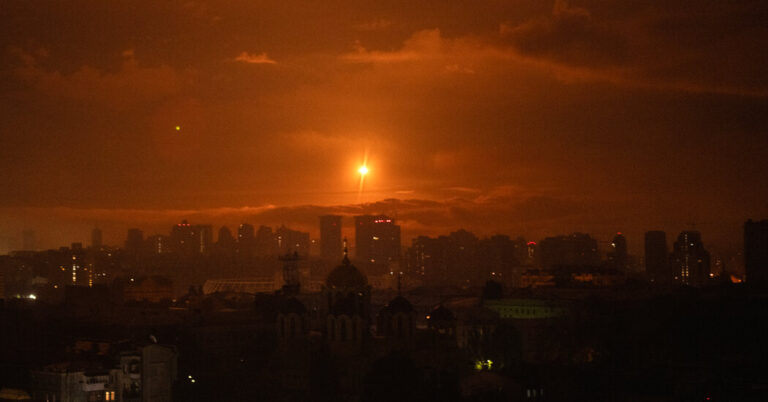Ukraine said on Wednesday that it had drawn on stocks of antiaircraft missiles recently replenished by the United States and other allies to shoot down 29 of 30 missiles and exploding drones that Russia had fired at the country in an overnight barrage.
It was one of the better rates of interception by Ukraine so far during the war and underscored the impact of having fresh supplies of Western weaponry to bolster a war effort that had struggled mightily in recent months.
In Kyiv, the authorities said they had shot down an entire volley of missiles and exploding drones aimed at the capital as the devices approached or soared above the city. The aerial duel, between mostly Western-provided air defense systems and incoming Russian missiles, played out over the city shortly before 3 a.m.
Earlier in the year, Ukraine’s air defense ammunition had run perilously low. Commanders at some batteries said their missiles were being rationed, allowing Russian missiles to streak in unimpeded. President Volodymyr Zelensky has repeatedly appealed for additional U.S.-made Patriot air-defense systems.
Mr. Zelensky reiterated the request on Wednesday when missiles or falling debris struck an apartment block in Kryvyi Rih, in central Ukraine, killing eight people and wounding 21 others. Those missiles were fired after the initial wave early on Wednesday.
The Biden administration has decided to give Ukraine one additional Patriot system, consisting of launchers, stocks of missiles and powerful radar antennas for finding targets. Other countries are also considering transferring Patriot launchers to Ukraine. Germany has organized the donation of 100 missiles from its stocks and those of Denmark, the Netherlands and Norway, of which 32 have been delivered so far, Germany’s defense minister, Boris Pistorius, said this week.
As the assault played out on Wednesday, flashes lit up the skyline and explosions rang out. One civilian was wounded by falling debris, the authorities said.
“The enemy launched another missile attack on the capital,” Kyiv’s military administrator said in a post on Telegram, the social networking site. Typical of recent Russian strikes, the attack combined several types of weapons, including drones and cruise missiles. The tactic is intended to overload Ukraine’s air defenses.
The cruise missiles, launched from bombers flying in Russian air space, were timed to arrive in Kyiv simultaneously with a volley of Iranian-designed Shahed exploding drones.
In the overall attack, according to the Ukraine Air Force, Russia also fired three ballistic missiles, an Iskander medium-range, ground-launched ballistic missile and two air-launched Kinzhal, or Dagger missiles, which are dispatched from airplanes and fly at hypersonic speeds. Ukrainian and Western officials have said that Patriot interceptors are the only defense against the Dagger missiles.
Ukraine shot down five of six missiles and all 24 Shahed drones, the air force said in a statement that could not be independently confirmed.
Ukraine’s interception rate for drones and missiles had fallen in the first months of this year compared with a year earlier, as its air defense ammunition ran low and Russia adapted tactics to evade what defenses there were.
The average shoot-down rate for drones for the 12 months through April was about 80 percent, data from the Ukraine Air Force shows. The interception rate for missiles had fallen in some months this year to less than 50 percent, the data indicated.
Beyond boosting air defenses, the arrival of American weaponry has helped steady teetering positions along the front line and, soldiers said, slowed a Russian assault in the northeastern Kharkiv region. Troops who had bemoaned a shortage of ammunition again opened fire.
Congress approved additional aid in April, after months of delays, and the U.S. military rushed to Ukraine ammunition for artillery and weapons such as Stinger short-range antiaircraft missiles and Javelin antitank missiles, replenishing Ukraine’s arsenal.
One effect, soldiers serving at artillery positions said, was a lifting of rationing rules that had prohibited taking shots at small groups of Russian soldiers, because it was not deemed worthwhile to expend limited ammunition on them. Now, Ukrainian forces could provide fire support for frontline soldiers facing such assaults by small units.
European countries have also ramped up supplies of air-defense missiles to Ukraine. With more missiles available for short, medium and long-range systems, Ukraine could be expected to increase its ratio of interceptions during Russian missile attacks, said Valeriy Romanenko, a senior researcher at Ukraine’s National Aviation University.
In addition to the long-range American Patriot systems and a French and Italian long-range system called the SAMP/T, Ukraine operates an array of Western short- and medium-range air-defense systems. These include NASAMS launchers, a U.S.-Norwegian design; American Hawk missiles; and a recently developed German system, IRIS-T.
The attack on Wednesday showed good results in downing cruise missiles, Mr. Romanenko said, but too few were fired to ascertain whether Ukraine’s air defenses have been fully restored after the shortages. The volley was possibly a probing attack by Russia to flush out the location of Ukrainian air-defense positions, he said. The real test would come with a larger barrage.
In neighboring Poland, the military said it had scrambled jets to defend its airspace while the Russian missiles were in flight in Ukraine.
In Kyiv on Wednesday, falling debris wounded the leg of one civilian, the city’s military administrator, Ruslan Kravchenko, said in another post on Telegram. Falling missile debris also started two fires.
Debris from intercepts — sometimes small, silvery shards of metal and at other times heavy rocket motors — rains down on Kyiv after such engagements, often causing injuries. The debris is from both the interceptors and the incoming Russian missiles.
In recent assaults, Russia has been targeting electrical power plants, and by this month, about half of Ukraine’s electrical generating capacity had been destroyed. The government has introduced nationwide rolling blackouts as a result.
Nataliia Novosolova contributed reporting.

